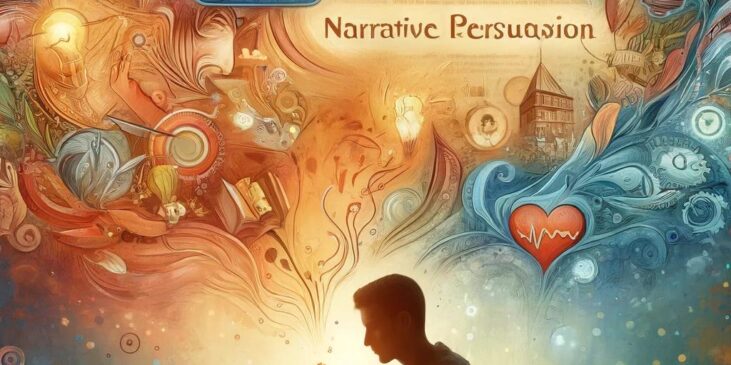Navigating AI Assistance in Academia: A Narrative Inquiry for Narrative Persuasion
Learning Objective:
Analyze the ethical implications and transparency requirements of using AI tools like ChatGPT in academic work by creating and discussing narrative scenarios exploring varied AI integration outcomes in student projects. This objective targets the higher-order cognitive analysis process in Bloom’s Taxonomy, encouraging students to dissect and examine the complexities of AI use in educational contexts.
Keywords: Ethical Implications, Narrative Persuasion, AI Transparency, Academic Integrity, Critical Analysis
Theoretical framework
Narrative Persuasion
Narrative Persuasion refers to the influential power of storytelling in shaping individuals’ knowledge, attitudes, and behaviors. This phenomenon is underpinned by the process of narrative transportation, wherein individuals become deeply engaged with the story, significantly amplifying the narrative’s impact. Key elements influencing the efficacy of narrative persuasion include the narrative frame, the perspective of the narrator, and the degree to which individuals identify with the characters within the story. Such narratives not only simplify complex issues—making them more accessible and relatable—but also foster emotional and cognitive engagement, enhancing their persuasive effectiveness. Research, such as studies on ocean plastic pollution and language evolution, demonstrates that strategically crafted stories can effectively encourage behavior change and support policy initiatives. Overall, narrative persuasion utilizes the compelling nature of stories to communicate impactful messages and drive substantial changes in behavior.
Insights from SLR
“Narrative persuasion refers to the persuasive power of stories in influencing knowledge, attitudes, and behavior by allowing deep cognitive and emotional immersion in the narrative world” (Sukalla, 2023).
“Narrative Persuasion is the process of being influenced by the contents of a story due to becoming immersed in it, as discussed in research on storytelling and narrative transportation” (Krause-Galoni & Mazzocco, 2023).
“Narrative persuasion is the use of stories to influence attitudes and behaviors. In the context of ocean plastic pollution, distance-framed narratives can effectively communicate risks to young adults” (Liu & Yang, 2023).
“Narrative Persuasion is the cognitive process of influencing beliefs or behaviors through storytelling, as explored in the context of language evolution and human communication in the paper” (Ferretti, 2022).
Framework for the activity:
- Introduction and Context Setting: Start by introducing the article and its main themes, focusing on the necessity of transparency when using AI tools like ChatGPT. Provide students with a brief overview of the capabilities and limitations of such tools.
- Narrative Development: Divide the students into groups and assign each group the task of creating a narrative around a hypothetical scenario in which a student uses ChatGPT to assist with different types of academic tasks. These tasks could range from generating ideas for a research paper to solving complex problems in STEM subjects. Each group should craft a story that includes:
- Initial Challenge: Describe the academic challenge the student faces.
- Intervention: Detail how the student uses ChatGPT to seek assistance.
- Outcome: Narrate the outcomes, both positive and negative.
- Critical Analysis: After the narratives are developed, each group presents their story to the class. Following each presentation, conduct a class discussion that encourages students to analyze:
- The ethical implications of using AI in academic work.
- The importance of transparency about AI assistance.
- The potential impacts (both beneficial and detrimental) on the learning process.
- Reflection and Writing: Finally, ask each student to write a reflective essay on the role of AI in education. They should discuss their personal stance on the ethical use of AI tools, the importance of transparency, and how AI can be used responsibly to enhance learning.
- Peer Review: Incorporate a peer review element where students critique each other’s essays, focusing on the depth of analysis and the persuasiveness of the narrative.
This activity not only engages students in critical thinking and ethical reasoning through a narrative persuasion framework but also enhances their understanding of the complexities involved in the use of AI in academic settings.
Didactic Sequence for a 40-Minute Class Activity:
1. Introduction (5 minutes):
- Briefly introduce the purpose and objectives of the activity.
- Explain the relevance of AI tools in academic settings and the importance of transparency.
2. Group Formation and Scenario Assignment (5 minutes):
- Divide students into small groups (3-4 members each).
- Assign each group a specific academic task that involves the use of AI, ensuring a variety of contexts (e.g., research, problem-solving, creative projects).
3. Narrative Development (10 minutes):
- Instruct each group to develop a short narrative around their assigned scenario.
- The narrative should include:
- A clear problem or challenge the student faces.
- ChatGPT is used to assist with the task.
- The outcomes emphasize both positive and negative consequences.
4. Group Presentations (10 minutes):
- Each group presents their narrative to the class, focusing on the ethical dilemmas and the transparency of AI use.
- Limit presentations to about 2 minutes each to stay within time constraints.
5. Class Discussion (5 minutes):
- Facilitate a discussion on the different narratives presented, focusing on:
- The ethical implications of using AI.
- The consequences of transparency or lack thereof.
- Please encourage students to reflect on how these narratives could relate to their own academic experiences.
6. Conclusion and Reflective Prompt (5 minutes):
- Summarize the key points discussed and the insights gained from the narratives.
- Assign a reflective writing task for homework where students will analyze their stance on AI assistance, focusing on ethics and transparency.
This sequence efficiently covers the activity’s goals within a 40-minute class period, ensuring active participation and critical engagement from all students.
Sources
Ferretti, F. (2022). Narrative Persuasion. A Cognitive Perspective on Language Evolution (1st ed.). Springer Nature. https://link.springer.com/book/10.1007/978-3-031-09206-0
Krause-Galoni, R., & Mazzocco, P. (2023). Storytelling and Narrative Persuasion. In C. Lamberton, D. D. Rucker, & S. A. Spiller (Eds.), The Cambridge Handbook of Consumer Psychology (2nd ed., pp. 28–52). Cambridge University Press. https://doi.org/10.1017/9781009243957.004
Liu, S., & Yang, J. Z. (2023). Narrative persuasion and psychological distance: Analyzing the effectiveness of distance-framed narratives in communicating ocean plastic pollution. Risk Analysis, 43(10), 2099–2113. https://doi.org/10.1111/risa.14111
Sukalla, F. (2023). Narrative Persuasion – theoretische Ansätze und empirische Ergebnisse zur Überzeugungskraft von Narrationen. Soziale Passagen, 15(1), 23–37. https://doi.org/10.1007/s12592-023-00458-4

